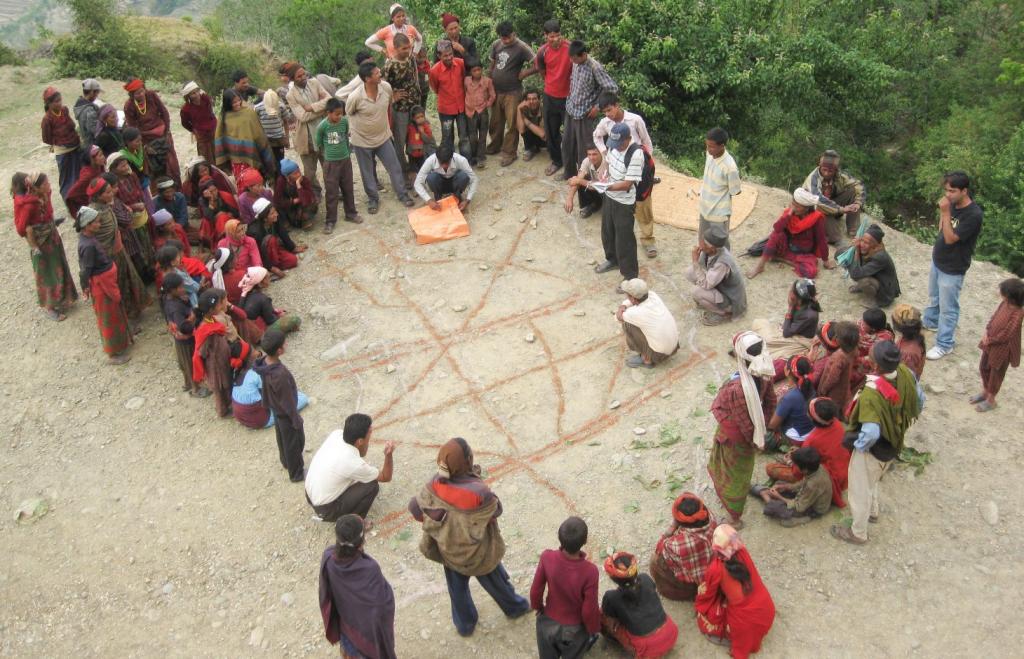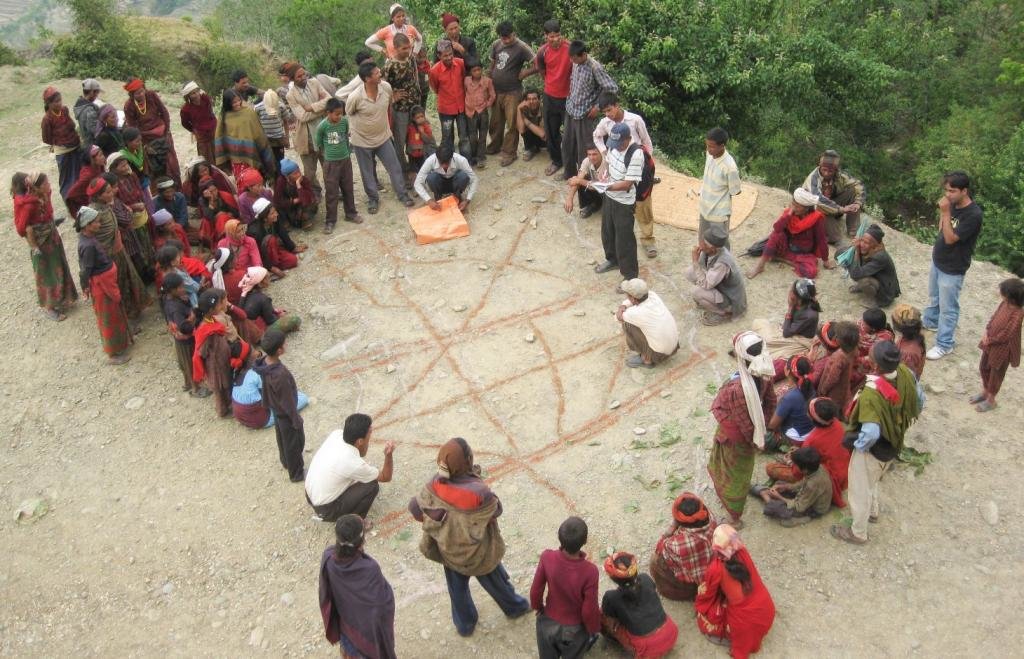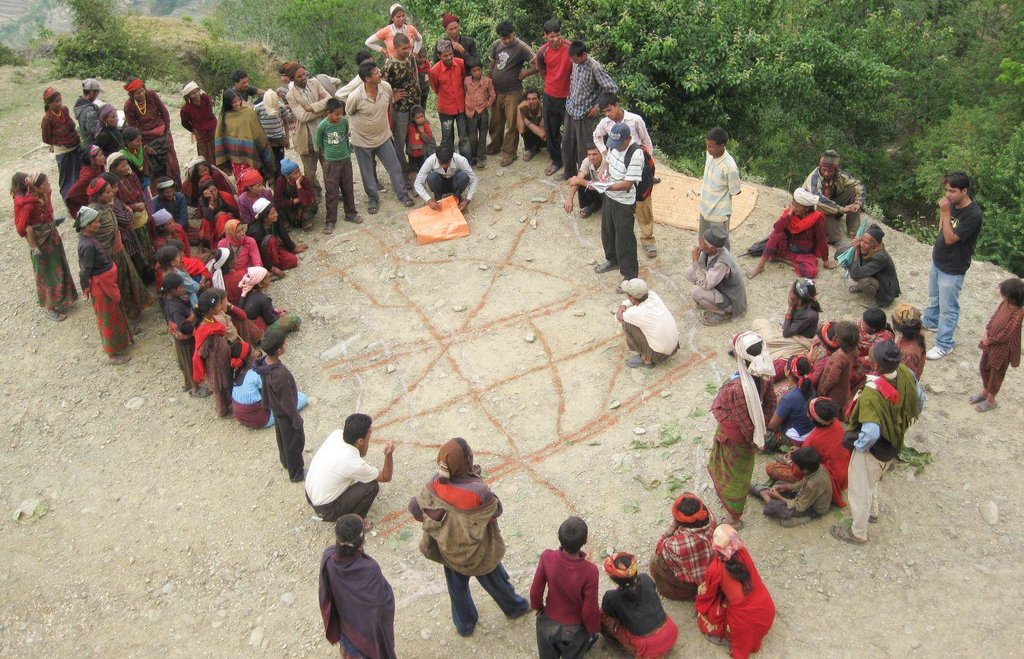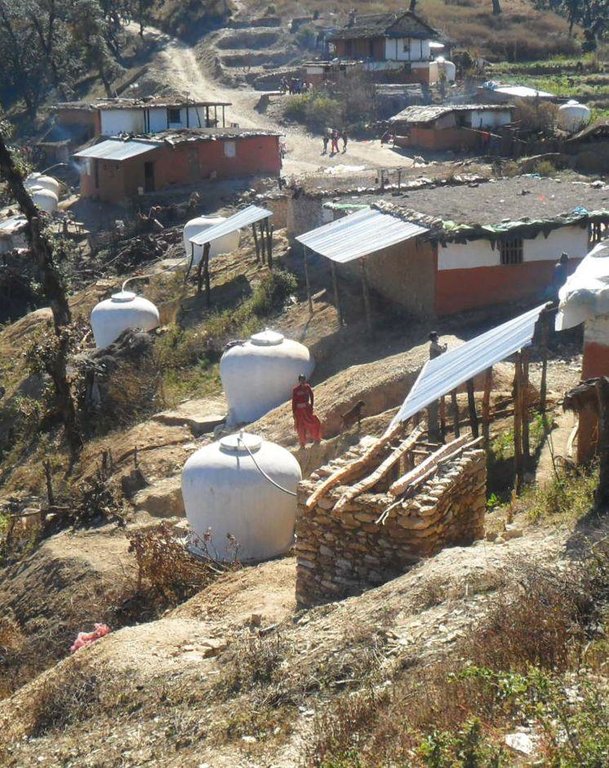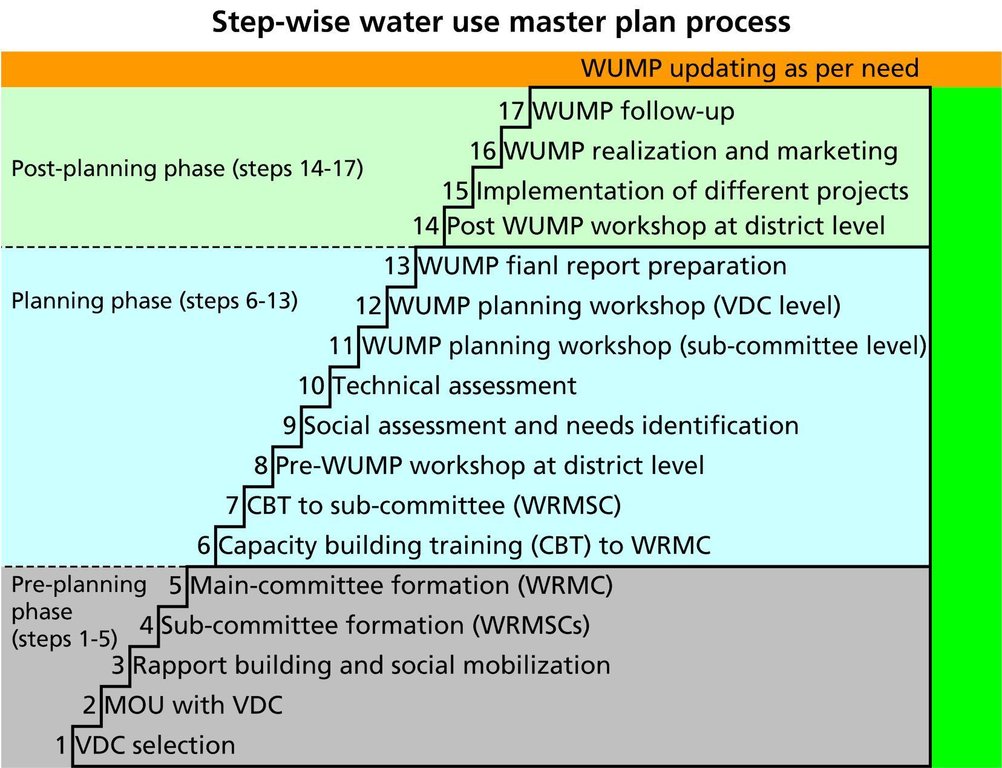Water use master plan [Непал]
- Создание:
- Обновить:
- Составитель: Shreedip Sigdel
- Редактор: –
- Рецензент: Fabian Ottiger
Jal upoyog guru yogana (Main Contributor: HELVETAS Nepal)
approaches_2535 - Непал
Просмотреть разделы
Развернуть все Свернуть все1. Общая информация
1.2 Контактные данные специалистов и организаций, участвующих в описании и оценке Подхода
Специалист по УЗП:
Jürg Merz
+977 1 5524925; 9851044421 (M)
juerg.merz@helvetas.org.np
HELVETAS Swiss Intercooperation Nepal
Швейцария
Название организации (-ий), содействовавших документированию/оценке Подхода (если применимо)
HELVETAS (Swiss Intercooperation)Название организации (-ий), содействовавших документированию/оценке Подхода (если применимо)
ICIMOD International Centre for Integrated Mountain Development (ICIMOD) - Непал1.3 Условия, регламентирующие использование собранных ВОКАТ данных
Когда были собраны данные (на местах)?
01/03/2013
Составитель и ответственный/-ые специалист(-ы) согласны с условиями, регламентирующими использование собранных ВОКАТ данных:
Да
2. Описание Подхода УЗП
2.1 Краткое описание Подхода
A water use master plan supports the development of integrated water resources at the local level; all stakeholders, including disadvantaged groups, take part in the plan.
2.2 Подробное описание Подхода
Подробное описание Подхода:
Aims / objectives: A water use master plan (WUMP) is a holistic, participatory, and inclusive planning process that takes an integrated approach to the management of water resources and uses at the village level. The WUMP specifies the total water budget for its planning unit, the village development committee (VDC), and explores potential uses for it. It empowers marginalized groups to claim their rights to an equitable share of water within and between communities. The WUMP also helps local bodies with annual and periodic planning and project prioritization.
Methods: The WUMP is a 17-step process that includes social mobilization, the formation of inclusive management committees, capacity building for everyone involved in the process, and, as a final step, social assessment using various participatory rural appraisal (PRA) tools. Simultaneously, the technical part of the process evaluates the capacity of all water resources and their potential uses. In a workshop facilitated by NGO staff, the community discusses suggestions formulated by the two participatory assessments, prioritizes possible projects, and formulates plans. The VDC representatives decide which plans can be implemented using their own resources and which need external support. The WUMP then organizes a workshop to present these plans to various organizations in order to get their commitment and support. The prioritized projects are implemented according to the WUMP.
The plan also contains a series of long-term activities and during the course of its implementation, there is sufficient latitude to allow the community to rectify its original plans in order to put into practise lessons learned during earlier phases and to continue to review and modify the plan as needed.
2.3 Фотографии, иллюстрирующие Подход
2.5 Страна/ регион/ место, где применялся Подход
Страна:
Непал
Более точная привязка места:
15 districts in the Western, Mid-Western, and Far-Western Development Regions of Nepal
2.7 Тип Подхода
- в рамках проекта/ программы
2.8 Каковы цели/ задачи Подхода
The Approach focused mainly on SLM with other activities (Water conservation, water sources and catchment area)
• Establish inclusive water planning and water resource management at the community level
• Ensure the optimal use of water resources; see that water is equitably and efficiently distributed
• Promote conservation of water and natural resources linked to water; implement water projects based on the plan agreed by the entire community
The SLM Approach addressed the following problems: • Issues on access to water are often contentious, communities often quarrel over water rights
• A lack of coordinated planning at the local level
• A growing demand for water both for domestic and agricultural use
• Water sources are diminishing and the changing climate will further aggravate this
2.9 Условия содействующие применению Технологии/ Технологий в рамках Подхода или затрудняющие его
Социальные/ культурные/ религиозные нормы и ценности
- затрудняют
Communities are reluctant to share water resources and
hide the sources of water during planning
Treatment through the SLM Approach: Earn everyone's trust through meetings, dialogue, and social mapping that includes all stakeholders including disadvantaged groups.
Наличие/ доступность финансовых ресурсов и услуг
- затрудняют
When the WUMP is implemented by the VDC using its
own funds it usually takes a long time.
Treatment through the SLM Approach: Collaborate and network with resource organizations such as INGOs and donor funded programmes for funding.
Институциональные условия
- затрудняют
There is no elected body in the VDC and no one takes permanent ownership of the WUMP.
Treatment through the SLM Approach: Create an advisory body consisting of representatives from all political parties.
Нормативно-правовая база (землевладение, права на земле- и водопользование)
- содействуют
Ensuring equitable use of water resources is a key feature of the WUMP approach.
Осведомленность в области УЗП, доступность технической поддержки
- затрудняют
When the administrative boundaries of a VDC do not coincide with its physical watershed boundaries, it can be difficult to make technical decisions.
Treatment through the SLM Approach: Cluster VDCs into groups in the same sub/watershed.
другие
- затрудняют
Low awareness of the need for conservation and of the
need to use water efficiently
Treatment through the SLM Approach: Intensive awareness raising and capacity building programmes
3. Участие и распределение ролей заинтересованных сторон
3.1 Заинтересованные стороны, участвующие в реализации Подхода и их роли
- местные землепользователи/ местные сообщества
VDC
Equal participation of men and women is encouraged during the social assessment and needs identification phase. During the planning and implementation phases, the participation of women in decision making is ensured through a provision that there be a representation of at least 33% women in the water resource management committees, sub-committees, and users' committees. Disadvantaged groups (Dalit and Janajati among others) are requested to participate in numbers proportional to the percentage they represent in the community in all activities and committees.
- учителя/ преподаватели/ школьники / студенты
- общественные организации
HELVETAS
- государственные власти (отвечающие за планирование или принятие решений)
3.2 Участие местных землепользователей/ местных сообществ на разных стадиях реализации Подхода
| Участие местных землепользователей/ местных сообществ | Перечислите участников и опишите их вовлеченность | |
|---|---|---|
| инициирование/ мотивация | интерактивное | Community meetings, decision taken by the VDC on how to prepare the WUMP |
| планирование | интерактивное | Social and resource mapping, social assessments, technical assessments and planning |
| выполнение | самоорганизация | Implementation of the water projects, source protection/conservation |
| мониторинг/ оценка | интерактивное | Review of the plan, community monitoring during the construction phase, follow-up monitoring during routine operation |
| Research | нет |
3.3 Схема реализации (если имеется)
Описание:
The step-wise WUMP process
VDC = Village development committee
MOU = Memorandum of understanding
WRMC = Water resource management committee
WRMSC = Water resource management sub-committee
WUMP = Water use master plan
(AK Thaku)
3.4 Принятие решений по выбору Технологии/ Технологий УЗП
Укажите, кто принимал решение по выбору применяемой Технологии/ Технологий:
- в основном землепользователи при поддержке специалистов по УЗП
Поясните:
Technologies are selected on the basis of suitability and availability of water sources by local communities with the support of technicians and the VDC.
Decisions on the method of implementing the SLM Technology were made by mainly by land users supported by SLM specialists. Since the VDC endorses the WUMP, it decides on implementation.
4. Техническая поддержка, повышение компетенций и управление знаниями
4.1 Повышение компетенций/ обучение
Проводилось ли обучение землепользователей/ других заинтересованных лиц?
Да
- Local Community
Рассматриваемые темы:
• Social mobilization and awareness raising orientations, training
• Capacity building and training to WRMC and local service providers
4.3 Институциональная (организационная) поддержка
В ходе реализации Подхода были ли организованы новые институциональные структуры или поддержаны уже существующие?
- да, существенно
Укажите уровень, на котором структуры были укреплены или вновь созданы:
- местные
Укажите тип поддержки:
- повышение компетенций/ обучение
- оборудование
Подробнее:
Support is provided to the VDC for the preparation of the WUMP
4.4 Мониторинг и оценка
Являются ли мониторинг и оценка частью Подхода?
Да
Комментарии:
bio-physical aspects were monitored through measurements; indicators: Follow-up monitoring to check if the water sources are protected, and if the area is conserved by planting
technical aspects were monitored through measurements; indicators: Follow-up monitoring to check water sources and number of water projects implemented
socio-cultural aspects were monitored through measurements; indicators: Public hearings and audits to ensure transparency and community participation (especially of disadvantaged groups)
area treated aspects were monitored through measurements; indicators: Follow-up monitoring of implementation (as shown in the diagram )
no. of land users involved aspects were monitored through measurements; indicators: Public review, final commissioning: community contribution and participation (as shown in the diagram)
management of Approach aspects were monitored through measurements; indicators: WUMP follow-up: implementation of WUMP (as shown in the diagram )
Implementation of WUMP aspects were monitored through measurements; indicators: WUMP follow-up: implementation of WUMP (as shown in the diagram )
There were few changes in the Approach as a result of monitoring and evaluation: • All members of the community, even those with water resources on their own land, are willing to share water resources after participating in the WUMP.
• Disadvantaged groups participate on an equal footing in management committees and have equal access to water resources.
• The community realizes the need to protect water resources and begins to conserve water.
5. Финансирование и внешняя материальная поддержка
5.1 Годовой бюджет мероприятий по УЗП в рамках Подхода
Если точный годовой бюжет неизвестен, укажите примерный диапазон затрат:
- 2000-10000
Комментарий (например, основные источники финансирования/ ключевые доноры):
Approach costs were met by the following donors: national non-government: 75.0%; local community / land user(s): 25.0%
5.2 Финансирование и внешняя материальная поддержка, предоставляемая землепользователям
Предоставлялась ли землепользователям финансовая/ материальная поддержка для применения Технологии /Технологий?
Нет
5.3 Субсидии на отдельные затраты (включая оплату труда)
- нет
Если труд землепользователя был существенным вкладом, укажите, был ли этот вклад:
- добровольный
5.4 Кредитование
Предоставлялись ли в рамках Подхода кредиты на мероприятия УЗП?
Нет
6. Анализ влияния и заключительные положения
6.1 Влияние Подхода
Сумел ли Подход помочь землепользователям внедрить и поддерживать технологии УЗП?
- Нет
- Да, немного
- Да, умеренно
- Да, существенно
Water, forests, and land are all interlinked. Proper management of water resources, source protection, and conservation are all part of sustainable land management.
Сумел ли Подход расширить возможности социально и экономически уязвимых групп?
- Нет
- Да, немного
- Да, умеренно
- Да, существенно
Disadvantaged groups participate and share benefits on equal terms.
Did other land users / projects adopt the Approach?
- Нет
- Да, немного
- Да, умеренно
- Да, существенно
This approach has been replicated by the Rural Water Resources Management Project of FINNIDA, the LIVE/EU project, and Nepal Water for Health (NEWAH), a national-level NGO in Nepal. Nepal's Ministry of Local Development, Department of Local Infrastructure and Roads, has expressed an interest in developing WUMPs for all the VDCs in Nepal.
Did the Approach lead to improved livelihoods / human well-being?
- Нет
- Да, немного
- Да, умеренно
- Да, существенно
Having access to sustainable water resources improves livelihoods.
Did the Approach help to alleviate poverty?
- Нет
- Да, немного
- Да, умеренно
- Да, существенно
Access to water improves hygiene and contributes to better health and to poverty alleviation.
6.2 Основные причины, побуждающие землепользователей внедрять УЗП
6.3 Долгосрочная устойчивость мероприятий в рамках Подхода
Могут ли землепользователи самостоятельно (без внешней поддержки) продолжать применение того, что было реализовано в рамках Подхода?
- нет уверенности
Если нет или нет уверенности, объясните почему:
In order to ensure sustainability the following issues need to be addressed:
• Social: Coordinated planning in consultation with the local people; capacity building at all levels so that management committees, local service providers, local government, and the community as a whole can participate better, voice their concerns, and be part of the solution.
• Economic: The VDCs take a lead role, the beneficiaries need to be willing to share the costs and need to want to participate in activities such as quality control, and routine operation and maintenance schemes.
• Environment: Conservation of water sources, integrated water resources planning, and the efficient use of water
6.4 Сильные стороны/ преимущества Подхода
| Сильные стороны/ преимущества/ возможности по мнению составителя или других ключевых специалистов |
|---|
| Communities appreciate the WUMP approach (How to sustain/ enhance this strength: The Ministry of Local Development has expressed an interest in preparing national guidelines for this process in order to scale it up to all the VDCs in Nepal) |
| VDCs own the process both by participating and by contributing to the funding. (How to sustain/ enhance this strength: Need to simplify the process and make it more cost effective so that it is easier to replicate.) |
| An integrated approach to the use of water resources may help in climate change adaptation. (How to sustain/ enhance this strength: Strengthen awareness activities and continue to promote water conservation) |
|
The WUMP process is inclusive and is managed by the whole community. (How to sustain/ enhance this strength: Continue to strengthen the capacity of disadvantaged groups so that they can participate more actively.) |
6.5 Слабые стороны/ недостатки Подхода и пути их преодоления
| Слабые стороны/ недостатки/ риски по мнению составителя или ответственных специалистов | Возможные пути их преодоления/снижения? |
|---|---|
| Not all VDCs actively participate in the WUMP | When VDCs contribute funds for the WUMP, they are usually more actively involved. |
| Communities can have high expectations for WUMP but their VDCs may have limited resources. | The VDCs need to communicate clearly with their community so that they can prepare a realistic plan together. |
| Conflicts can arise over the allocation of water resources | The VDC and the management committee must work with the community to see that any contentious issues are resolved equitably |
|
At times it can be difficult to get everyone to agree to a given WUMP. |
The VDC authorities can improve their negotiating skills in order to make their demands heard with donors and district development committees. |
7. Справочные материалы и ссылки
7.1 Методы сбора/источники информации
- выезды на места, полевые обследования
- опросы землепользователей
7.2 Ссылки на опубликованные материалы
Название, автор, год публикации, ISBN:
Water use master plan preparation guideline. Lalitpur, Nepal: WARM-P/HELVETAS; Rural Village Water Resource Management Project (2011) Proceedings of water use master plan national level experience sharing workshop. Lalitpur, Nepal, HELVETAS (2007)
Ссылки и модули
Развернуть все Свернуть всеСсылки
Нет ссылок
Модули
Нет модулей


